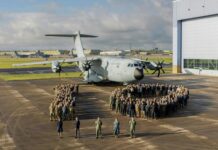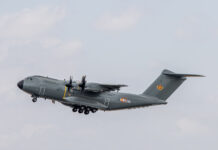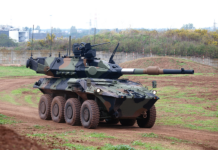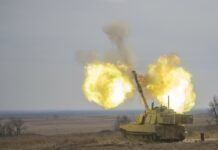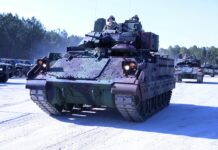Armoured vehicle design is based on the so called ‘iron triangle’ of firepower, protection and mobility. The most successful vehicles are those that achieve the best balance between these three criteria. Other factors come into play though, including the operational doctrine of the operator driving the specifications of the vehicle, the tasks that the vehicle is expected to perform and the industrial capabilities of the user in terms of design, development, manufacturing and long-term support.
Put simply, designing an armoured vehicle is a complicated process and despite armoured vehicles being designed and developed for over 100 years, the possibility of failure remains ever present. Not every country can call on an indigenous armoured vehicle design, development and manufacturing base. In these conditions, the country needs to acquire its armour from foreign suppliers and then look to adapt it to meet its needs. Obviously, in an ideal world, an army would prefer to obtain a vehicle perfectly adapted to meet its operational needs from in-country suppliers; in this environment, long-term support and vehicle upgrade possibilities would be implicit. However, being realistic means looking for practical solutions in terms of armour acquisition.
Acquiring capability
Australia provides an excellent example of meeting armoured vehicle capabilities by acquiring foreign vehicles, while at the same time making the establishment of an indigenous industrial capability for the manufacture and support components of the acquisition programme. Under the LAND 400 Phase 2 programme, Australia signed a contract with Rheinmetall in August 2018 to acquire 211 Boxer armoured vehicles. A key element of the contract was the establishment of the Military Vehicle Centre of Excellence (MILVEHCOE) in Ipswich, Queensland, in partnership with the Queensland State Government. MILVEHCOE would ‘finalise’ the 25 Block 1 Boxer vehicles supplied from Germany prior to delivery to the Australian Army; it would then be responsible for the manufacture and delivery of 186 Block 2 Boxer vehicles, as well as long-term Boxer support.
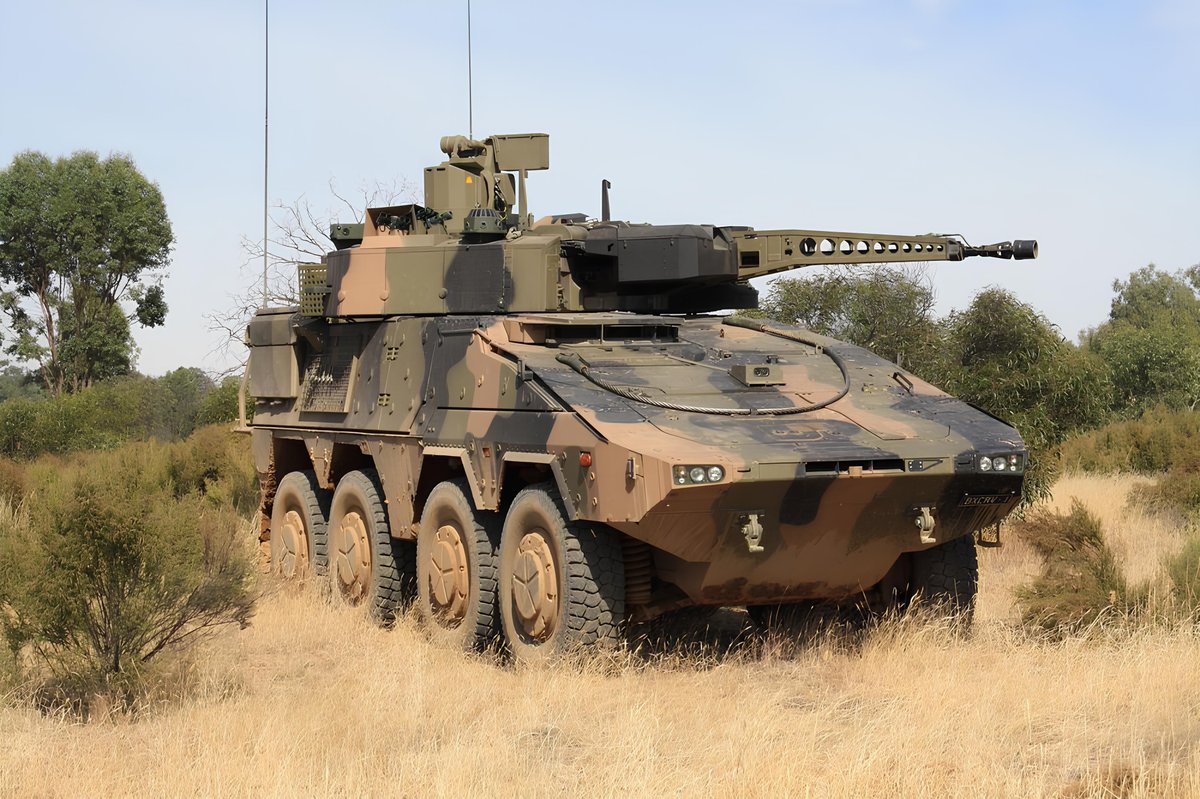
Credit: Rheinmetall
LAND 400 was an extremely ambitious programme; the Phase 2 Boxer acquisition was followed by the Phase 3 part of the programme, which covered the replacement of the M113AS3/AS4 APC and its variants, with a modern infantry fighting vehicle (IFV). The same logic applied in this acquisition, with local manufacture and support being a key element of the programme. Originally the intention had been to acquire up to 450 IFVs, as well as 17 manoeuvre support vehicles (MSV), the latter being a combat engineering vehicle based on the selected IFV’s base platform. Subsequently, the Australian Army looked to expand the scope of the programme with the acquisition of mortar carriers, mortar ammunition carriers and logistics vehicles, again based on the IFV design.
Unfortunately for the Australian Army, as it was looking to bring its LAND 400 Phase 3 to a conclusion, the Australian economy took a downturn, putting pressure on the defence budget. A new government instituted a ‘Defence Strategic Review (DSR),’ which recommended that the LAND 400 Phase 3 acquisition be dramatically reduced to 129 IFVs. Hanwha Defense Australia (HDA) and their AS21 Redback IFV were selected for the programme, with the vehicle to be manufactured by HDA at their local facility in Geelong, Victoria. This facility is also responsible for the manufacture of 30 AS9 Huntsman self-propelled artillery systems and 15 AS10 armoured ammunition resupply vehicles being acquired under the LAND 8116 Protected Mobile Fires programme.
The LAND 400 armoured vehicle acquisition programmes represented a major capability gain for the Australian Army. They also have an important strategic element; deployment across the Australian landmass covers strategic distances and often over complex terrain and in areas with limited transport infrastructure. The DSR referenced the requirement for littoral manoeuvre operations by the Australian Army; implicit in this is the requirement to deploy beyond Australia, a clear endorsement of strategic power projection. LAND 400 is an example of how existing armoured vehicles can be specified by export customers for requirements that include a strategic power projection element.
Adapting existing vehicles to meet national operational requirements is the path that most nations will have to follow, but not everybody will be able or willing to include an armoured vehicle industrialisation element for local manufacture and support as Australia has done. For many, it is a matter of operating within available budgets, or perhaps deciding that strategic power projection is and will remain far beyond national capabilities. If a requirement to deploy strategically did emerge, in those circumstances it would be necessary to piggyback on the capabilities of allied or friendly nations for transport to the area of operations and subsequent support. Such situations are certainly common for smaller European nations that look to participate or are, perhaps, leaning towards participating in international operations for peacekeeping/peace-making missions.
Operational requirements
The requirements for designing an armoured vehicle are predicated on the operational environment that those specifying the system anticipate fighting within and the doctrine that they intend to employ in combat operations. Matters would be very simple indeed if an armoured vehicle was to be used solely in a limited geographically defined area with relatively benign environmental factors to be considered. Sadly for those looking for simple solutions, the majority of armoured vehicles today should be able to operate in the widest possible spectrum of geographical and climatic conditions.
Another set of factors come into play when looking at the operational requirements to cope with anticipated threat levels. With armoured vehicles, if peer or near-peer level opponents are to be confronted, this represents a key factor in how a vehicle’s firepower, protection and mobility characteristics are balanced. Moreover, the threat never remains static, hence the need for a growth margin in the vehicle design to accommodate upgrades, such as additional protection and the implications that might have on other vehicle characteristics such as mobility.
To further complicate matters, the need to operate in unexpected environments against constantly-evolving threats presents new challenges in armoured vehicle design. For the majority of the past 20 years, Western militaries have found themselves embroiled in asymmetric conflicts from Africa, to the Middle East and to South Asia. Initially, it was assumed that these conflicts were essentially counter-insurgency campaigns, something that was familiar to these militaries in the post-1945 era. In these circumstances, existing armoured vehicles were seen as adequate, with an emphasis on light armour, as the threats were not deemed sufficient to warrant heavier protection.

Credit: Bundeswehr/Mario Bähr
Of course, Western militaries soon discovered that they were not dealing with the post-colonial insurgencies of yore, as the threat was far greater and opponents far better-equipped than anticipated. Operations in Iraq and Afghanistan demonstrated that insurgents had access to light anti-armour weapons, mines and the ability to construct increasingly sophisticated improvised explosive devices (IEDs). This gallery of threats quickly rendered much of the light armour considered adequate for counter-insurgency missions dangerously redundant. In turn, this created a demand for more effectively protected vehicles, eventually leading, amongst other things, to the widespread adoption of a new vehicle category – the mine resistant ambush protected (MRAP) armoured vehicle.
The asymmetric conflicts in Iraq and Afghanistan also saw major developments in vehicle protection of in-service armour; the evolution of the British Army Warrior IFV in this context is noteworthy. The Warrior entered service with the British Army in 1986, and at that time its vehicle weight was some 25 tonnes, with the armour designed to survive 155 mm artillery fragments and 14.5 mm AP rounds. Warrior first saw combat in January 1991 as a part of Operation Granby to liberate Kuwait, with vehicle protection increased by the addition of an appliqué armour package developed by Vickers Defence Systems which was installed on-site in the Middle East.
Warrior’s protection would grow dramatically in the 2000s to meet threats encountered in Iraq (Operation Telic) and then in Afghanistan (Operation Herrick). In late 2007, Warrior IFVs in Iraq had the WRAP 2 armour package fitted with the installation conducted in Kuwait; this consisted of explosive reactive armour (ERA), slat armour and ECM equipment amongst other additions. Warrior IFVs arrived in Afghanistan in 2007 and their protection levels were incrementally upgraded beyond WRAP 2 standards to meet evolving threat levels. The downside of this was increased vehicle weight and this started to impinge on vehicle mobility. This set the scene for what might be described as the ‘ultimate’ Afghanistan Warrior upgrade.
This new upgrade programme was known as Theatre Entry Standard – Herrick TES(H), with 70 Warrior vehicles going through the upgrade process. The objective was to improve protection, restore mobility and increase reliability. As previously noted, Warrior originally weighed in at roughly 25 tonnes, with the first raft of protection upgrades seeing a weight increase to 30 tonnes and by the time TES(H) came on the scene, Warrior was a nearly 40-tonne vehicle. Mobility enhancements included suspension and ride-height modifications, final drive changes and improved brakes, modular armour additions, air conditioning and numerous other changes.

Credit: Crown Copyright
The TES(H) Warrior performed well in Afghanistan, with the only downside being the question of weight. The modular armour package in TES(H) could be downscaled to reduce weight, but there were risks involved in reducing protection. Deploying a TES(H) specified Warrior in a hurry over strategic-level distances was also difficult, as the only British military asset capable of lifting it was a C-17 transport aircraft. If the British Army found itself looking to deploy a reasonable force with armour and heavy weapons capabilities over a significant distance, such a force would quickly deplete British strategic air transport capabilities.
Deployability and pre-positioning
Ultimately, the issue of deploying armour over strategic distances is down to the time available and the amount of weight to be moved. Other issues need to be taken into account if light armour is to be made easier to move, but if it is overmatched by the threat it is going to meet once deployed, there is little point in moving it at all. To develop a vehicle capable of being used as a part of strategic power projection will still require that the classic compromise between firepower, protection and mobility is successfully achieved. However, designing a successful vehicle that meets all desired operational criteria in a weight and dimensionally restricted package will always be incredibly difficult.
There are other options to provide strategic power projection possibilities for armour and these are well proven. A case in point is the US Army Prepositioning Strategy and Prepositioning of Materiel Configured in Unit Sets (POMCUS) programme, more recently referred to as Army Prepositioned Stocks (APS). During the Cold War, the US Army would need to rapidly reinforce its forces in Germany and this could not be achieved by shipping troops and equipment from the US. Instead, the US and other NATO members paid for the establishment of POMCUS sites where divisional sets of equipment could be kept in controlled storage conditions, with personnel on-site to conduct equipment maintenance for the equipment to be kept in battle-ready condition. All that was needed was to fly the personnel from the US to operate the equipment. The utility of POMCUS was proven by the annual US Army Return of Forces to Germany (REFORGER) exercises.
During Operations Desert Shield and Desert Storm in 1990/91, equipment from POMCUS locations was transported by air and sea to the Middle East and prepared for combat operations. In the aftermath of the first Gulf War, the US Army established POMCUS, by that point known as APS, in Kuwait and Qatar to support future combat operations. These APS sites played a critical role as US forces returned to the Middle East in 2003 for Operation Iraqi Freedom. Post-2003 equipment at these APS sites was used later to support combat operations in both Iraq and Afghanistan.
Having equipment stockpiles in the potential area of operations and using that equipment in periodic reinforcement exercises, demonstrates ongoing commitment to security in a region, as well as providing the basis for a rapid response to a crisis situation. Having heavy equipment at hand for large-scale, ground combat operations (LSGCO) also acts as a deterrent. Placing APS locations in Europe, the Middle East and Asia arguably provides a far more robust structure for strategic power projection instead of relying on shipping personnel and equipment over strategic distances via airlift or sealift.

Credit: US Army
The APS strategy is not without its faults, as there is always the danger that equipment in store will be used to equip new units and will never be replaced at the APS, something that has already occurred. Organisational and budgetary issues have also impacted the utility of the APS strategy; examples of this are maintenance being deferred leading to equipment unserviceability at APS sites and consequently not being fit for issue. If sites are kept properly stocked and managed, the APS concept remains one of the most logical solutions to provide the basis for strategic power projection.
Systemic issues
In the final analysis, there are still questions that need answering regarding the movement of armour and ground forces across strategic distances in pursuit of power projection objectives. These include the distance to be covered and the speed needed for the planned movement. Then comes the crux of the matter which relates to the opponent to be deterred or fought and their level of threat. If the threat environment features potentially confronting a peer or near-peer competitor in a high-intensity conventional conflict environment, then heavy armour, artillery and other high-end capabilities are needed. That means undertaking a major logistics challenge in delivering heavy equipment in a timely manner to where it is needed and in fighting shape on arrival. Beyond that is the need to sustain operations, another equally burdensome logistics challenge.
Within Europe, strategic movement of armour from the western to the eastern boundary of NATO will inevitably make heavy use of railway transport. European armies have planned on using rail transport for major troop and materiel movements since the middle of the 19th century. The challenges involved and the requirements for successful utilisation are well known, although railways remain vulnerable to disruption by both covert and overt means.

Credit: Crown Copyright
For strategic-level movements of heavy forces further afield, it is a matter of sealift. Organic military sealift assets are massively reduced compared to those of the Cold War era, as it is now a matter of acquiring commercial shipping assets such as car carriers and large ‘roll-on, roll-off’ (Ro-Ro) ferries to move heavy units. Obtaining suitable commercial vessels, having them move to the appropriate ports, correctly loading the vessels, arranging movement instructions and timetables, plus providing a suitable escort to the destination port all takes time, with more time required to unload, organise and then begin movement to operational locations. Sealift is still responsible for the majority of world trade and there is no substitute for sealift in moving bulk cargo, but this is not a rapid response option in terms of power projection.
This brings us to airlift, which is clearly the optimum response if rapid power projection over strategic distances is required. The problem here as far as Europe is concerned is that they are limited in terms of suitable military airlift assets, with the Boeing C-17 and Airbus A400M being the most useful options. For larger loads, it comes down to utilising the few commercial An-124 aircraft in Europe though Russian-owned aircraft of this type are obviously out of the question, or looking to US support in the form of C-5 missions. Currently, Europe possesses enough available military airlift capacity to rapidly move a tripwire force with some light armour to act as a deterrent, secure ground locations, such as a port, to await the arrival of the main force by sea for example. However, a tripwire force would be extremely vulnerable until reinforced.
If there is a requirement to have a power projection capability that can rapidly move a viable force over strategic distances, then there needs to be a rethink of what kind of armour capability is essential to cope with the majority of threat scenarios. While it would be attractive to rapidly move top-of-the-range 60-70 tonne tanks in serious numbers along with all their required support, as well as IFVs, artillery systems and other assets to deter or project power, it is just not possible under current circumstances.
The future
Looking ahead, technology may yet provide crucial answers to in terms of providing a viable armour solution to support strategic power projection requirements. The true next generation of tanks is characterised by solutions such as the proposed Franco-German Main Ground Combat System (MGCS) which is now scheduled to enter service at some point between 2040 and 2045. A number of future concepts have been discussed in the context of MGCS, which include unmanned ground vehicles (UGV) and autonomous systems operating as part of a constellation or ‘system of systems’. Other developments include looking to fire support vehicles lighter than tanks. A notable recent example is the M10 Booker, selected under the US Army’s Mobile Protected Firepower (MPF) programme, which promises to provide much-needed capability while being more suited to rapidly deploy to remote locations than its heavier counterparts.

Credit: GDLS
Looking beyond the aforementioned programmes, technologies such as UGVs, autonomous systems and secure operational networks provide the basis for the development of lightweight armour solutions that could be rapidly transported by air to potential zones of conflict at strategic distances. Suitably-equipped UGVs and autonomous systems interlinked with robust command and control systems could potentially have the capability to deter or confront hostile heavy forces. Such a capability could also have the ability to hold ground until the main operational force arrives by sea.
The future course for armoured systems to meet the requirements of strategic power protection is more capability, though with much less weight. This will potentially allow more armoured systems to be deployed, thereby reducing risk in conventional, asymmetric, peacekeeping and peace-making mission environments. UGVs and autonomous systems can provide the solution for more capability at lower weight, with the added bonus that they could offer a reduced need for personnel to be deployed in hazardous situations.
In the meantime, until technology alleviates the weight versus capability problems, mission planners should be very careful in assessing the operational environment that armour is committed to if power projection missions are undertaken. The human cost of the erroneous assumption that light armour was perfectly adequate to deal with the threats encountered in Afghanistan should never be repeated.
David Saw





![What next for Abrams? A US Army M1A2 Abrams main battle tank (MBT) from Comanche Company, 4th Battalion, 6th Infantry Regiment moves to a refuelling point during Exercise Talisman Sabre 23 at the Townsville Field Training Area, Townsville, Australia, 25 July 2023. [US Army/Spc Charlie Duke]](https://euro-sd.com/wp-content/uploads/2025/09/original-Kopie-218x150.jpg)
